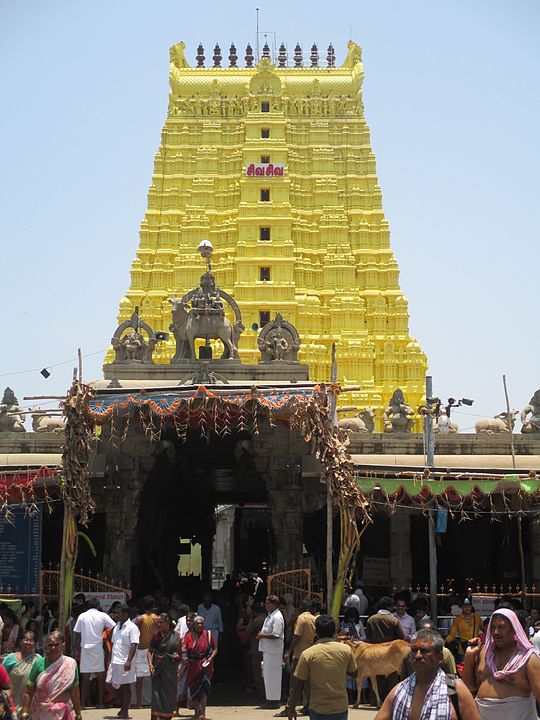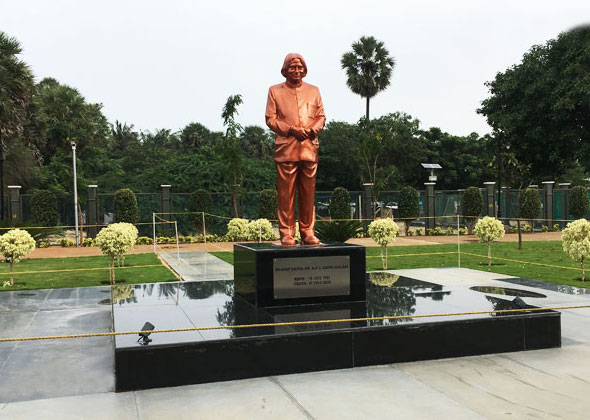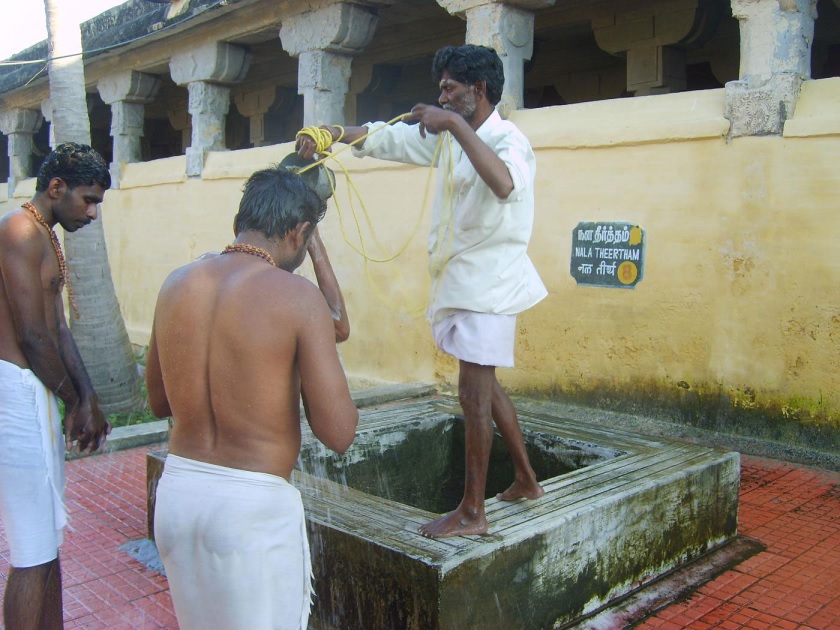Rameshwaram, located in the southern Indian state of Tamil Nadu, has a rich and multifaceted history that spans thousands of years. The town’s historical significance is deeply intertwined with its religious and cultural heritage. Here are the Top things to do.
Ancient History:
- Rameshwaram’s history can be traced back to ancient times, and it is mentioned in various ancient Indian texts and scriptures.
- The town is closely associated with the Ramayana, one of the most revered epics in Hindu mythology.
- According to the Ramayana, Lord Rama, along with his consort Sita and his loyal devotee Hanuman, embarked on a journey to Rameshwaram. They came to this sacred place to worship Lord Shiva and seek his blessings before building a bridge (Rama’s Bridge or Adam’s Bridge) to reach Lanka (Sri Lanka) to rescue Sita from the demon king Ravana.
Religious Significance:
- Rameshwaram is renowned for the Ramanathaswamy Temple, a prominent Hindu temple dedicated to Lord Shiva. This temple is considered one of the Char Dhams (four sacred pilgrimage sites) for Hindus, along with Badrinath, Dwarka, and Puri.
- The temple is believed to have been established by Lord Rama himself after his victorious return from Lanka. It is said to be the site where Lord Rama worshiped Lord Shiva and sought forgiveness for having killed Ravana, a devotee of Shiva.
- The temple’s history is marked by various dynasties and rulers who contributed to its architecture and expansion over the centuries.
Colonial Period:
During British colonial rule, Rameshwaram remained an important center for pilgrimage and trade. The British constructed the Pamban Bridge in 1914, connecting Rameshwaram to the mainland, which played a crucial role in the region’s development and accessibility.
10 Things things to do in Rameshwaram:
- Explore Ramanathaswamy Temple
- Visit Dhanushkodi Beach
- Take a Walk on Pamban Bridge
- Marvel at Abdul Kalam Memorial
- Discover Gandhamadhana Parvatham
- Bathe in Agnitheertham
- Witness the Floating Stones at Adam’s Bridge
- Explore Kothandaramaswamy Temple
- Enjoy a Boat Ride to Kurusadai Island
- Experience the Taste of Local Cuisine
1. Explore the Famous Ramanathaswamy Temple :
Ramanathaswamy Temple, located in the town of Rameshwaram in the Indian state of Tamil Nadu, is one of the most significant and revered Hindu temples in the country. It holds immense religious and historical importance and is dedicated to Lord Shiva, in the form of Ramanathaswamy (the Lord of Rama). Here are some key details about the temple:
Religious Significance: Ramanathaswamy Temple is a part of the Char Dham pilgrimage and is considered one of the 12 Jyotirlinga shrines dedicated to Lord Shiva. It is believed that a pilgrimage to Rameshwaram is equivalent to visiting the other three Char Dhams (Badrinath, Dwarka, and Puri).
Architecture: The temple’s architecture is a fine example of Dravidian style, with towering gopurams (gateway towers) that are adorned with intricate sculptures and carvings. The temple complex covers a vast area and has several corridors and pillared halls.
Corridors and Pillared Halls: Ramanathaswamy Temple is famous for its long and ornate corridors, particularly the outer corridor, which is the longest in the world. It stretches for about 6.9 meters (23 feet) and has thousands of intricately carved pillars. The temple also has 22 theerthams (holy water bodies) where devotees take ritual baths.
Ramanathaswamy Lingam: The main deity of the temple is the lingam (an abstract representation of Lord Shiva), known as the Ramanathaswamy Lingam. It is believed to have been established by Lord Rama himself after his return from Lanka.
Legend of Rameshwaram: According to the Ramayana, Lord Rama prayed to Lord Shiva at this very spot to seek forgiveness for having killed Ravana, a Brahmin and a devotee of Shiva. Lord Rama is said to have built a lingam here and worshiped Lord Shiva to absolve himself of the sin of killing Ravana.
Agni Theertham: The temple is located near the Agni Theertham beach, where it is customary for pilgrims to take a ritual bath before entering the temple. This is believed to purify the soul.
Festivals: The temple witnesses grand celebrations during festivals like Mahashivaratri and Navratri when thousands of devotees throng the temple premises to offer their prayers.
Pilgrimage Destination: Rameshwaram is a major pilgrimage destination for Hindus, and the temple is a significant part of the pilgrimage experience. Devotees believe that a visit to this temple will cleanse them of their sins and grant them spiritual salvation.
Rituals: Various rituals and ceremonies are performed throughout the day at the temple, including elaborate aarti (prayer rituals) and abhishekam (ritual bathing of the deity).
Visiting Tips: When visiting Ramanathaswamy Temple, it’s important to follow the dress code and temple etiquette. Modest clothing is required, and men are typically required to wear a dhoti while entering the sanctum sanctorum. It’s advisable to check the temple’s schedule and timings before planning your visit.
Ramanathaswamy Temple is not only a place of worship but also an architectural marvel that offers a glimpse into the rich cultural and religious heritage of India. It continues to be a place of deep spiritual significance for millions of devotees who visit it annually.

2. Explore the other Famous temples near to Rameshwaram:
Rameshwaram, a sacred pilgrimage site in Tamil Nadu, India, is home to several temples apart from the famous Ramanathaswamy Temple. These temples hold religious and historical significance and are worth exploring during your visit to the region. Here are some of the notable temples in Rameshwaram:
- Agnitheertham Temple: Located near Ramanathaswamy Temple, Agnitheertham is not only a holy beach but also the site where Lord Rama is believed to have offered prayers to Lord Shiva before embarking on his journey to Lanka. Devotees take ritual baths here before visiting Ramanathaswamy Temple.
- Kothandaramaswamy Temple: Situated around 12 kilometers from Rameshwaram, this temple is associated with Lord Rama and is believed to be the place where Lord Rama performed the last rites of Ravana. It offers picturesque views of the sea and is a peaceful place to visit.
- Jada Tirtham Temple: This temple is located near Dhanushkodi and is dedicated to Lord Rama. It is known for its holy well, which is believed to have been created by Lord Rama by shooting an arrow into the ground to quench the thirst of his troops.
- Kashi Viswanathar Temple: Situated near Ramanathaswamy Temple, this shrine is dedicated to Lord Shiva and is associated with the sacred Kashi pilgrimage. Devotees often visit this temple as part of their pilgrimage to Rameshwaram.
- Nambu Nayaki Amman Temple: This temple is dedicated to Goddess Parvati and is located near Ramanathaswamy Temple. It is known for its colorful and intricate architecture.
- Five-faced Hanuman Temple: Located in Rameshwaram town, this temple is dedicated to Lord Hanuman. It is known for its unique Hanuman idol with five faces, representing Lord Hanuman in five different forms.
- Ramalinga Vilasam Palace: Although not a temple, this historic palace in Rameshwaram is associated with the legacy of Sethupathi rulers and offers insights into the history of the region. It’s worth a visit to learn about the royal heritage of Rameshwaram.
- Ujjaini Mahakali Temple: Located near Dhanushkodi, this temple is dedicated to Goddess Mahakali. It is situated close to the sea and offers scenic views of the coastline.
- Gandhamadhana Parvatham Temple: This temple is situated on a small hillock and offers panoramic views of Rameshwaram. It is believed to be the place where Lord Hanuman searched for the medicinal herb, Sanjeevani, to save Lord Lakshmana in the Ramayana.
- Panchamukhi Hanuman Temple: Located on the way to Dhanushkodi, this temple is dedicated to Lord Hanuman with five faces. It’s a peaceful spot for meditation and reflection.
These temples in Rameshwaram collectively contribute to the spiritual and cultural richness of the region and offer a diverse range of experiences for pilgrims and tourists alike. When visiting these temples, it’s advisable to check their opening hours and any specific customs or rituals to be followed.
3. Explore the Dhanushkodi Beach :
Dhanushkodi Beach is a unique and historically significant destination located on the southeastern tip of India’s Pamban Island in Tamil Nadu. It holds a special place in the hearts of both tourists and history enthusiasts due to its intriguing history and stunning natural beauty. Here are some key details about Dhanushkodi Beach:
- Geographical Significance: Dhanushkodi is situated at the confluence of the Bay of Bengal and the Indian Ocean, making it a significant geographic point on India’s map. It is located approximately 20 kilometers (12 miles) from the town of Rameshwaram.
- Historical Background: Dhanushkodi holds historical importance primarily due to its association with the Ramayana, an ancient Indian epic. According to legend, this is the place where Lord Rama, the hero of the Ramayana, built a bridge (Rama’s Bridge or Adam’s Bridge) of floating stones to reach Sri Lanka in order to rescue his wife, Sita, from the demon king Ravana. The name “Dhanushkodi” itself means “end of the bow,” symbolizing the place where Lord Rama’s bow came to rest after the successful building of the bridge.
- Cataclysmic Event: Dhanushkodi was once a thriving town with a railway station, post office, and numerous houses. However, in 1964, the town was severely affected by a cyclone that resulted in massive destruction and loss of life. The cyclone washed away most of the town, leaving it in ruins. As a result, Dhanushkodi is often referred to as a “ghost town.”
- Natural Beauty: Despite its tragic history, Dhanushkodi is known for its breathtaking natural beauty. The beach is surrounded by the turquoise waters of the Indian Ocean on one side and the calmer waters of the Bay of Bengal on the other. The contrast of the two oceans meeting at this point is a sight to behold.
- Religious Significance: Dhanushkodi is also a place of religious significance. Pilgrims often visit the Dhanushkodi Temple, which is dedicated to Lord Rama. It is believed that Lord Rama performed a ritual bath here before beginning his journey to Lanka.
- Accessibility: Dhanushkodi is accessible by road from Rameshwaram. Visitors can take a jeep ride to reach the beach as there is no regular public transport to this remote location. The road journey itself is an adventure as it takes you through sandy terrain and along the coastline.
- Tourist Activities: While at Dhanushkodi Beach, visitors can enjoy activities like beachcombing, photography, and taking in the serene atmosphere. It’s also a popular spot for sunset views, and the panoramic vistas make it a photographer’s paradise.
- Caution: Swimming at Dhanushkodi Beach can be risky due to strong currents and unpredictable waves. Visitors are advised to exercise caution and follow local guidelines while at the beach.
Dhanushkodi Beach is a place that blends history, spirituality, and natural beauty, making it a must-visit destination for travelers interested in exploring India’s diverse and culturally rich landscapes. Its remote location and unique history contribute to its allure as a hidden gem in South India.
4. Enjoy the Incredible Architecture of Pamban Bridge :
Pamban Bridge, also known as the Pamban Sea Bridge, is an iconic railway bridge located in the southern part of India, specifically in the state of Tamil Nadu. It is a remarkable engineering feat and holds historical significance as one of India’s most renowned bridges. Here are some key details about the Pamban Bridge:
- Type of Bridge: The Pamban Bridge is a cantilever bridge, which means it is supported by horizontal beams anchored at one end and extending over a body of water. It is often referred to as a “cantilever truss bridge” due to its truss-like structure.
- Historical Significance: The bridge holds historical importance as it was opened to traffic in 1914, making it one of the oldest sea bridges in India. It was constructed during British colonial rule to establish a rail link between the Indian mainland and the island of Rameshwaram.
- Length and Architecture: The Pamban Bridge spans approximately 2.3 kilometers (1.4 miles) and is a vital transportation link for both trains and vehicles. It features a central double-leaf bascule section that can be raised to allow the passage of ships and vessels through the Palk Strait, connecting the Bay of Bengal with the Indian Ocean.
- Engineering Marvel: At the time of its construction, the Pamban Bridge was considered a marvel of engineering, given its location in a cyclone-prone area and the challenging sea conditions it had to withstand. The bridge’s design allows it to withstand the region’s frequent high winds and tidal movements.
- Importance for Transportation: The Pamban Bridge is a crucial transportation link, facilitating both passenger and freight train services to and from Rameshwaram. It is a lifeline for the residents of Rameshwaram and a popular means for pilgrims visiting the Ramanathaswamy Temple.
- Scenic Views: The journey across the Pamban Bridge offers stunning panoramic views of the sea and the surrounding landscape. Travelers often find the experience of crossing the bridge to be both thrilling and scenic.

5. Abdul Kalam Memorial:
The Abdul Kalam Memorial, officially known as the “Dr. APJ Abdul Kalam National Memorial,” is a dedicated museum and memorial in honor of Dr. Avul Pakir Jainulabdeen Abdul Kalam, who was India’s 11th President and a renowned scientist and engineer. The memorial is located in the town of Rameshwaram in Tamil Nadu, India, Dr. Kalam’s birthplace.
Here are some key details about the Abdul Kalam Memorial:
- Location: The memorial is situated on the picturesque island of Rameshwaram, which holds great religious and cultural significance. It is located in the Pei Karumbu area of Rameshwaram, near the former residence of Dr. Kalam’s family.
- Inauguration: The Abdul Kalam Memorial was inaugurated on July 27, 2017, on the occasion of Dr. Kalam’s second death anniversary. It was inaugurated by the then President of India, Pranab Mukherjee.
- Design and Architecture: The memorial is designed to showcase the life and achievements of Dr. Kalam. It features a striking architectural design that incorporates elements of both traditional and modern styles. The memorial complex includes a statue of Dr. Kalam, a library, an auditorium, and various exhibits.
- Exhibits and Artifacts: Inside the memorial, visitors can explore exhibits and artifacts related to Dr. Kalam’s life and work. These include personal belongings, photographs, awards, scientific instruments, and documents that highlight his contributions to India’s space and missile programs.
- Replica of Dr. Kalam’s Workspace: One of the highlights of the memorial is the replica of Dr. Kalam’s workspace, which showcases his work desk, books, and personal items, providing visitors with a glimpse into his daily life.
- Interactive Displays: The memorial also features interactive displays and multimedia presentations that help visitors understand Dr. Kalam’s scientific contributions and his vision for India’s development.
- Inspirational Quotes: Throughout the memorial, visitors can find inspirational quotes and messages from Dr. Kalam, reflecting his commitment to education, innovation, and national development.
- Library: The memorial houses a library with a collection of books, journals, and publications related to Dr. Kalam’s areas of expertise, including aerospace engineering and missile technology.
- Auditorium: The complex includes an auditorium where events, lectures, and educational programs are conducted to promote Dr. Kalam’s ideals and inspire young minds.
- Visitors’ Center: The Abdul Kalam Memorial has a visitors’ center that provides information and guidance to tourists and pilgrims who come to Rameshwaram.
The Abdul Kalam Memorial serves as a fitting tribute to the “People’s President” and “Missile Man of India.” It is a place of inspiration, education, and reflection, where visitors can learn about Dr. Kalam’s life journey, his dedication to science and technology, and his vision for a brighter future for India. It has become a popular destination for students, researchers, and admirers of Dr. Kalam from across the country and around the world.

6. Explore Gandhamadhana Parvatham:
- Gandhamadhana Parvatham is a small hill and pilgrimage site located on the island of Rameshwaram in the southern Indian state of Tamil Nadu. This site is known for its religious significance and panoramic views of the surrounding landscape. Here are some key details about Gandhamadhana Parvatham:
- Geographical Location: Gandhamadhana Parvatham is situated on the southern tip of Rameshwaram Island, near the town of Rameshwaram. It is easily accessible by road and is a popular destination for both pilgrims and tourists.
- Religious Significance: The hill is associated with an episode from the Ramayana, an ancient Indian epic. According to Hindu mythology, this is the place where Lord Hanuman collected medicinal herbs to heal the wounds of Lord Lakshmana during the battle with the demon king Ravana in Lanka (Sri Lanka).
- Hanuman Temple: At the summit of Gandhamadhana Parvatham, there is a temple dedicated to Lord Hanuman. The temple houses an idol of Lord Hanuman and is a place of worship for devotees. It is believed that Lord Hanuman stood on this hill to search for the Sanjeevani herb to save Lord Lakshmana’s life.
- Panoramic Views: One of the main attractions of Gandhamadhana Parvatham is the breathtaking panoramic views it offers. From the hilltop, visitors can enjoy a 360-degree view of Rameshwaram, the Pamban Bridge, the Bay of Bengal, and the surrounding islands. It’s a popular spot for photographers and nature enthusiasts.
- Pilgrimage and Meditation: Many devotees and tourists visit Gandhamadhana Parvatham not only for its historical and religious significance but also for its serene and peaceful atmosphere. It’s an ideal place for meditation and reflection.
- Stairs to the Summit: To reach the temple at the hill’s summit, visitors need to climb a flight of stairs. While the climb can be a bit strenuous, the effort is rewarded with the mesmerizing views and the spiritual experience at the temple.
- Idol of Lord Hanuman: The temple on Gandhamadhana Parvatham houses an idol of Lord Hanuman in a seated posture with a mountain in his hand, symbolizing the herb-laden mountain he carried to Lanka.
- Sunset Views: Gandhamadhana Parvatham is also known for offering spectacular views of the sunset over the Arabian Sea. Many tourists gather here in the evenings to witness this natural spectacle.
- Timings: The temple on Gandhamadhana Parvatham is typically open to visitors from early morning to late evening. However, it’s a good idea to check the specific visiting hours when planning your trip.
- Gandhamadhana Parvatham is not only a place of religious importance but also a serene retreat that allows visitors to connect with nature and experience the spiritual aura of Rameshwaram. It offers a unique blend of history, mythology, and natural beauty, making it a popular destination for pilgrims and tourists alike.
7. Remember to Bath Agnitheertham Rameshwaram:
Agnitheertham is one of the sacred theerthams (holy water bodies) in Rameshwaram, Tamil Nadu, India, and it holds great religious significance in Hinduism. The term “Agnitheertham” is derived from two words: “Agni,” which means fire, and “theertham,” which refers to holy water. Here are some key details about Agnitheertham in Rameshwaram:
- Location: Agnitheertham is situated along the shores of the Bay of Bengal in Rameshwaram, near the Ramanathaswamy Temple. It is easily accessible, and its location makes it a significant pilgrimage site.
- Religious Importance: Agnitheertham is considered one of the 22 theerthams (sacred bathing spots) in Rameshwaram, and it holds a special place in Hindu religious traditions. Taking a ritual bath in its waters is believed to purify the body and soul, absolve sins, and bring spiritual blessings.
- Agni Worship: The name “Agnitheertham” is associated with Lord Agni, the Hindu god of fire. It is believed that Lord Rama, during his journey to Lanka as described in the Ramayana, invoked Lord Agni and offered prayers here before building the bridge to Lanka.
- Ritual Bath: Devotees and pilgrims who visit Rameshwaram make it a point to take a ritual bath in the waters of Agnitheertham before proceeding to the Ramanathaswamy Temple for darshan (sacred viewing) of the deity. This bathing ritual is an essential part of the pilgrimage.
- Pilgrimage Tradition: Bathing in Agnitheertham is seen as an act of purification and devotion. Many pilgrims consider this sacred bath as a way to cleanse themselves of sins and seek Lord Shiva’s blessings before entering the temple.
- Morning Hours: The best time to visit Agnitheertham for the ritual bath is during the early morning hours, which are considered the most auspicious time for such activities.
- Offerings and Prayers: After taking a dip in the sea at Agnitheertham, pilgrims often offer prayers, light lamps (deepams), and perform rituals as an expression of their devotion and gratitude.
- Conservation Efforts: In recent years, there have been efforts to maintain the cleanliness and sanctity of Agnitheertham and other theerthams in Rameshwaram. Pilgrims are encouraged to keep the area clean and respect the traditions associated with these sacred sites.
- Agnitheertham is not only a place of religious significance but also a cultural and spiritual experience for pilgrims and visitors to Rameshwaram. It reflects the rich religious heritage and traditions of the region and continues to draw devotees seeking spiritual purification and blessings.
8. Floating Stones at Adam’s Bridge:
- The “Floating Stones at Adam’s Bridge,” also known as “Rama’s Bridge” or “Rama Setu,” is a geological formation located between India and Sri Lanka. This natural formation has been the subject of both scientific interest and cultural mythology. Here are the key details about the Floating Stones at Adam’s Bridge:
- Geological Formation: The Floating Stones at Adam’s Bridge are a chain of limestone shoals, sandbanks, and coral reefs that stretch across the Palk Strait, a shallow body of water separating the southeastern coast of India (Tamil Nadu) from the northwestern coast of Sri Lanka.
- Mythological Significance: According to Hindu mythology, this formation is believed to be the remnants of the bridge built by Lord Rama, the hero of the Ramayana, to reach Lanka (Sri Lanka) to rescue his wife, Sita, from the demon king Ravana. It is often referred to as “Rama Setu” or “Rama’s Bridge” in connection with this legend.
- Cultural and Religious Significance: Rama Setu holds immense cultural and religious significance in India, particularly among Hindus. It is considered a sacred site, and the belief in its association with Lord Rama’s epic journey is deeply rooted in Hindu tradition.
- Historical References: Historical references to Adam’s Bridge can be found in ancient Indian texts like the Ramayana and the Mahabharata. These texts describe the construction of the bridge and its role in Lord Rama’s expedition to Lanka.
- Scientific Interpretation: From a scientific perspective, Adam’s Bridge is considered a natural formation resulting from geological processes. It is composed of sand, clay, and limestone shoals, formed by sedimentation and the action of ocean currents and tides.
- Rising Controversy: Over the years, the cultural and scientific aspects of Adam’s Bridge have sparked controversy and debate. Some individuals and groups assert that the bridge’s formation supports the historical accuracy of the Ramayana, while others emphasize the geological explanation.
- NASA Images: In 2002, NASA released satellite images of Adam’s Bridge, which showed a series of submerged structures resembling a man-made causeway. However, NASA clarified that the formation could be attributed to natural processes and not necessarily indicative of a man-made bridge.
- Conservation and Environmental Concerns: The region around Adam’s Bridge is ecologically sensitive, and there have been efforts to protect its fragile ecosystem. Conservationists and environmentalists have raised concerns about the impact of development and dredging activities on the area.
- Adam’s Bridge remains a site of cultural, religious, and historical significance for many, and it continues to be a subject of interest for both researchers and tourists. Whether viewed through a lens of mythology or geology, it offers a unique and intriguing aspect of the cultural heritage and natural beauty of the region

9. Explore Kothandaramaswamy Temple:
- The Kothandaramaswamy Temple is a Hindu temple located in the town of Rameshwaram in the southern Indian state of Tamil Nadu. This temple is dedicated to Lord Rama and is known for its religious and historical significance. Here are some key details about the Kothandaramaswamy Temple:
- Location: The Kothandaramaswamy Temple is situated approximately 12 kilometers (about 7.5 miles) from the town of Rameshwaram on the way to Dhanushkodi. It is located on the shores of the Bay of Bengal and offers picturesque views of the sea.
- Religious Significance: The temple is dedicated to Lord Rama, one of the principal deities in Hinduism. It is associated with an episode from the epic Ramayana, where Lord Rama performed the last rites of Jatayu, the eagle demigod, who valiantly fought to rescue Sita from the demon king Ravana.
- Jatayu’s Samadhi: The Kothandaramaswamy Temple is said to be the place where Lord Rama and his brother Lakshmana performed the last rites (cremation) of Jatayu, who had been mortally wounded while trying to protect Sita from Ravana’s abduction.
- Historical Artefacts: Inside the temple complex, you can find sculptures and inscriptions depicting scenes from the Ramayana, including Lord Rama, Lakshmana, and Sita. These historical artefacts add to the temple’s cultural and religious significance.
- Architecture: The temple features Dravidian architectural elements, which are characteristic of many South Indian temples. Its intricate and beautifully carved sculptures are notable, and the temple’s design reflects the rich heritage of Tamil temple architecture.
- Location near Dhanushkodi: The temple’s proximity to Dhanushkodi, a ghost town with historical significance, makes it a common stop for tourists and pilgrims exploring the region. Dhanushkodi is located at the southeastern tip of Rameshwaram Island.
- Scenic Views: The Kothandaramaswamy Temple offers stunning views of the Bay of Bengal, making it a picturesque spot to visit. The serene surroundings and the sound of the sea add to the temple’s tranquil atmosphere.
- Pilgrimage: Devotees and tourists often visit the Kothandaramaswamy Temple as part of their pilgrimage to Rameshwaram. It provides an opportunity for them to pay their respects to Lord Rama and immerse themselves in the religious and historical significance of the site.
- The Kothandaramaswamy Temple is not only a place of worship but also a historical and cultural treasure that offers insights into the epic Ramayana and its enduring significance in Indian mythology. The temple’s tranquil setting and its connection to the larger pilgrimage circuit in Rameshwaram make it a must-visit destination for those exploring the region’s religious and historical heritage.
10. Boat Ride to Kurusadai Island Rameshwaram:
A boat ride to Kurusadai Island from Rameshwaram offers a unique and memorable experience for travelers visiting the region. Kurusadai Island, also known as “Kurusadai National Park,” is a small, ecologically significant island located in the Gulf of Mannar, near Rameshwaram. Here’s what you need to know about taking a boat ride to Kurusadai Island:
- Location: Kurusadai Island is situated at a distance of approximately 15 kilometers (9.3 miles) from Rameshwaram. The boat ride to the island typically departs from the Rameshwaram fishing harbor.
- Ecological Significance: Kurusadai Island is part of the Gulf of Mannar Biosphere Reserve, a UNESCO World Biosphere Reserve. It is known for its diverse marine life, coral reefs, seagrass meadows, and unique ecosystem. The island is home to a variety of marine species, including sea turtles, dolphins, and numerous fish species.
- Boat Tours: To visit Kurusadai Island, you can arrange a boat tour from Rameshwaram. These tours are typically organized by local tour operators and can be booked at the Rameshwaram fishing harbor or through local travel agencies. The boat ride offers an opportunity to explore the marine biodiversity and the natural beauty of the region.
- Duration: The duration of the boat ride to Kurusadai Island can vary depending on the type of boat and the route taken. It usually takes around 1 to 1.5 hours to reach the island from Rameshwaram.
- Sightseeing and Activities: Once you reach Kurusadai Island, you can engage in various activities such as snorkeling, bird-watching, and exploring the island’s natural surroundings. The island is known for its coral formations, making it an excellent spot for snorkeling and underwater exploration.
- Marine Life: Keep an eye out for the diverse marine life that inhabits the waters around Kurusadai Island. If you’re lucky, you may spot sea turtles, dugongs (sea cows), and various species of fish. The island is also an important nesting site for sea turtles.
- Conservation: It’s essential to respect the conservation efforts in place to protect the fragile ecosystem of Kurusadai Island. Follow any guidelines provided by your boat tour operator, such as avoiding littering and disturbing the marine life.
- Ideal Time to Visit: The best time to visit Kurusadai Island is during the winter months, from October to March, when the weather is pleasant and the sea conditions are generally calm.
Before embarking on a boat ride to Kurusadai Island, it’s a good idea to check with local authorities or tour operators for the latest information on tour availability, safety guidelines, and any permits that may be required. This unique excursion allows you to appreciate the natural beauty and ecological significance of this remote island while enjoying a memorable adventure in the Gulf of Mannar.
11. Explore the Taste of Local Cuisine Rameshwaram:
Rameshwaram, located in the southern Indian state of Tamil Nadu, offers a delicious array of South Indian cuisine, with a focus on vegetarian dishes due to its religious significance. Here are some of the local and traditional dishes you can savor while visiting Rameshwaram:
Fresh Seafood: Given Rameshwaram’s coastal location, you can also savor fresh seafood dishes like fish curry, prawn masala, and crab curry in local restaurants.
Filter Coffee: South India is renowned for its filter coffee, which is strong, aromatic, and served with frothy milk. It’s often enjoyed after a meal or as a morning beverage.
Banana Leaf Meals: Some restaurants in Rameshwaram offer traditional South Indian meals served on banana leaves, featuring a variety of rice, curries, vegetables, and Traditional Palm Sugar Sweets.
Enjoy the Ice Apple: Ice apple, also known as “Nungu” in South India, is a tropical fruit commonly found in regions with hot and humid climates. Ice apples are typically in season during the summer months, which is when they are most abundant and readily available in local markets.

When dining in Rameshwaram, you’ll have the opportunity to savor the flavors of South Indian cuisine, and you’ll find plenty of vegetarian options to choose from. Be sure to explore the local eateries and restaurants to experience the authentic tastes of the region.
What’s the best time to visit Rameshwaram?
The best time to visit Rameshwaram is during the winter months, from October to April. This period offers pleasant weather with moderate temperatures, making it ideal for exploring the temples and other attractions in the region. Here’s a breakdown of the seasons and what to expect during each:
Winter (October to April):
Temperature: During the winter months, Rameshwaram experiences comfortable and relatively cooler temperatures. Daytime temperatures range from 20°C to 30°C (68°F to 86°F), while nights can be cooler.
Weather: The weather is dry and clear, making it perfect for sightseeing and outdoor activities.
Ideal for: This is the peak tourist season in Rameshwaram, and it’s the best time to visit if you want to avoid the extreme heat and humidity of the summer months. Pilgrims, tourists, and beach enthusiasts flock to Rameshwaram during this time.
Summer (May to June):
Temperature: Summer in Rameshwaram can be scorching, with daytime temperatures often exceeding 35°C (95°F) and even reaching up to 40°C (104°F).
Weather: It’s hot and dry during the summer months, and the region may experience occasional heatwaves.
Ideal for: Summer is not the most comfortable time to visit due to the high temperatures. However, if you can tolerate the heat, you can still visit the temples and enjoy the beaches early in the morning or late in the evening.
Monsoon (July to September):
Temperature: Monsoon brings relief from the summer heat, with temperatures ranging from 25°C to 30°C (77°F to 86°F).
Weather: Rameshwaram experiences moderate to heavy rainfall during the monsoon season. The region may be prone to occasional cyclonic activity, which can disrupt travel plans.
Ideal for: Monsoon is not the preferred time for tourism in Rameshwaram due to the rain and potential travel disruptions. However, if you enjoy the monsoon atmosphere and don’t mind some rain, you can visit during this time.
In summary, the best time to visit Rameshwaram for a comfortable and enjoyable experience is during the winter months, from October to April. This period offers pleasant weather, making it suitable for both pilgrimage and tourism. Be sure to plan your trip well in advance, especially if you intend to visit popular temples like Ramanathaswamy Temple, as they can get crowded during peak tourist season.
Places to Stay in Rameshwaram:
Rameshwaram offers a variety of accommodation options to suit different budgets and preferences. Whether you’re looking for luxury resorts, mid-range hotels, budget guesthouses, or spiritual lodges, you’ll find a range of places to stay in Rameshwaram. Here are some options to consider:
Luxury Resorts and Hotels:
Hyatt Place Rameswaram: A luxury hotel offering comfortable rooms, a swimming pool, and excellent dining options.
Daiwik Hotels Rameswaram: A well-appointed hotel known for its hospitality and proximity to the Ramanathaswamy Temple.
Tamil Nadu Tourism Development Corporation (TTDC) Hotel: This government-run hotel offers comfortable rooms and is located near the temple.
Mid-Range Hotels:
Hotel Pearl Residency: A mid-range hotel with modern amenities and a restaurant.
Hotel Vinayaga: A comfortable and well-maintained hotel with a convenient location.
Blue Coral Cottage: A budget-friendly hotel offering clean rooms and a friendly staff.
Budget Guesthouses and Lodges:
Rameswaram Lodge: A budget-friendly lodge with basic amenities.
Karthick Hotel: An affordable hotel with a convenient location.
Shree Jee Inn: A budget guesthouse offering clean and comfortable rooms.
Spiritual Lodges:
Many pilgrims prefer to stay in the spiritual lodges offered by the Ramanathaswamy Temple, which provide basic accommodation at a low cost. These lodges are close to the temple and offer a simple stay experience.
Homestays: You can find homestay options in and around Rameshwaram, offering a more personalized and local experience. These can be booked through various online platforms.
Beachfront Resorts: Some beachfront resorts, such as Daiwik Hotels and others, offer stunning views of the Bay of Bengal and a serene atmosphere.
Hotels Near Agnitheertham: If you want to be near Agnitheertham beach, you can consider staying in hotels located in that area.
Online Booking: You can use popular travel websites and booking platforms such as Booking.com, Agoda, MakeMyTrip, and TripAdvisor to search for and book accommodation in Rameshwaram. These platforms provide user reviews and ratings to help you make an informed choice.
Remember to book your accommodation in advance, especially during peak pilgrimage seasons, as Rameshwaram can get crowded. Additionally, it’s a good idea to check for any special packages or deals offered by hotels and resorts to make the most of your stay in this holy town.








